Reproducible hairy root transformation and spot-inoculation methods to study root symbioses of pea
- PMID: 22172023
- PMCID: PMC3264533
- DOI: 10.1186/1746-4811-7-46
Reproducible hairy root transformation and spot-inoculation methods to study root symbioses of pea
Abstract
Pea has lagged behind other model legumes in the molecular study of nodulation and mycorrhizae-formation because of the difficulty to transform its roots and its poor growth on agar plates. Here we describe for pea 1) a transformation technique which permits the complementation of two known non-nodulating pea mutants, 2) a rhizobial inoculation method which allows the study of early cellular events giving rise to nodule primordia, and 3) a targeted fungal inoculation method which allows us to study short segments of mycorrhizal roots assured to be infected. These tools are certain to advance our knowledge of pea root symbioses.
Figures
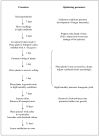

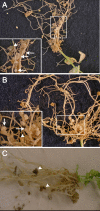

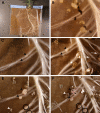
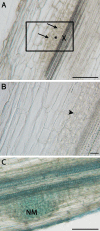
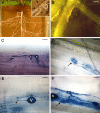
Similar articles
-
Agrobacterium rhizogenes-mediated transformation of Pisum sativum L. roots as a tool for studying the mycorrhizal and root nodule symbioses.PeerJ. 2019 Mar 6;7:e6552. doi: 10.7717/peerj.6552. eCollection 2019. PeerJ. 2019. PMID: 30863680 Free PMC article.
-
Common and divergent shoot-root signalling in legume symbioses.New Phytol. 2016 Apr;210(2):643-56. doi: 10.1111/nph.13779. Epub 2015 Dec 11. New Phytol. 2016. PMID: 26661110
-
The application of CRISPR/Cas9 in hairy roots to explore the functions of AhNFR1 and AhNFR5 genes during peanut nodulation.BMC Plant Biol. 2020 Sep 7;20(1):417. doi: 10.1186/s12870-020-02614-x. BMC Plant Biol. 2020. PMID: 32894045 Free PMC article.
-
[Comparative genetics and evolutionary morphology of symbiosis formed by plants with nitrogen-fixing microbes and endomycorrhizal fungi].Zh Obshch Biol. 2002 Nov-Dec;63(6):451-72. Zh Obshch Biol. 2002. PMID: 12510586 Review. Russian.
-
The Role of Gibberellins and Brassinosteroids in Nodulation and Arbuscular Mycorrhizal Associations.Front Plant Sci. 2019 Mar 15;10:269. doi: 10.3389/fpls.2019.00269. eCollection 2019. Front Plant Sci. 2019. PMID: 30930916 Free PMC article. Review.
Cited by
-
Use of ex vitro composite plants to study the interaction of cowpea (Vigna unguiculata L.) with the root parasitic angiosperm Striga gesnerioides.Plant Methods. 2012 Jun 28;8(1):22. doi: 10.1186/1746-4811-8-22. Plant Methods. 2012. PMID: 22741546 Free PMC article.
-
Dryas as a Model for Studying the Root Symbioses of the Rosaceae.Front Plant Sci. 2019 Jun 4;10:661. doi: 10.3389/fpls.2019.00661. eCollection 2019. Front Plant Sci. 2019. PMID: 31214211 Free PMC article.
-
Genotype-independent Agrobacterium rhizogenes-mediated root transformation of chickpea: a rapid and efficient method for reverse genetics studies.Plant Methods. 2018 Jul 6;14:55. doi: 10.1186/s13007-018-0315-6. eCollection 2018. Plant Methods. 2018. PMID: 29988950 Free PMC article.
-
Gene-based SNP discovery and genetic mapping in pea.Theor Appl Genet. 2014 Oct;127(10):2225-41. doi: 10.1007/s00122-014-2375-y. Epub 2014 Aug 15. Theor Appl Genet. 2014. PMID: 25119872 Free PMC article.
-
An anthocyanin marker for direct visualization of plant transformation and its use to study nitrogen-fixing nodule development.J Plant Res. 2019 Sep;132(5):695-703. doi: 10.1007/s10265-019-01126-6. Epub 2019 Jul 19. J Plant Res. 2019. PMID: 31325057 Free PMC article.
References
-
- Ellis THN, Poyser SJ. An integrated and comparative view of pea genetic and cytogenetic maps. New Phytol. 2002;153:17–25. doi: 10.1046/j.0028-646X.2001.00302.x. - DOI
-
- Dolgikh EA, Leppyanen IV, Osipova MA, Savelyeva NV, Borisov AY, Tsyganov VE, Geurts R, Tikhonovich IA. Genetic dissection of Rhizobium-induced infection and nodule organogenesis in pea based on ENOD12A and ENOD5 expression analysis. Plant Biol. 2011;13:285–296. doi: 10.1111/j.1438-8677.2010.00372.x. - DOI - PubMed
-
- Szczyglowski K, Stougaard J. Lotus genome: pod of gold for legume research. TIPS. 2008;13:515–517. - PubMed
-
- Timmers ACJ, Auriac M-C, Truchet G. Refined analysis of early symbiotic steps of the Rhizobium-Medicago interaction in relationship with microtubular cytoskeleton rearrangements. Development. 1999;126:3617–3628. - PubMed
LinkOut - more resources
Full Text Sources

